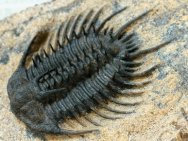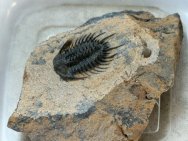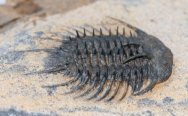 Description:
Elegant example of an unusual trilobite which as an Odontopleurid
has many fine relatives in Dicranurus,
Leonaspis, and Ceratonurus.
This one has a plethora of spines, most of which have been painstakingly
prepared freestanding, making for a spectacularly displayed specimen.
To what purpose could such a spiny armament be put? The answer
DEFENSE cries out; with fish
only recently having developed true jaws, any advantage a
prey species could evolve would stand it in good stead in the eternal
predator/prey arms race. I have seen this one listed as Diacanthaspis
in commercial offerings, but this one is different in possession
of paired spines in the axial ring. This one is a member of the
genus Proceratocephala. The known species, Proceratocephala terribilis
has 3 spines between the long pygidial spines, while this one
has four. As a consequence, it may be an as yet undescribed species.
Whatever its exact affinities, it is a truly stunning Lower Odovician
trilobite. Description:
Elegant example of an unusual trilobite which as an Odontopleurid
has many fine relatives in Dicranurus,
Leonaspis, and Ceratonurus.
This one has a plethora of spines, most of which have been painstakingly
prepared freestanding, making for a spectacularly displayed specimen.
To what purpose could such a spiny armament be put? The answer
DEFENSE cries out; with fish
only recently having developed true jaws, any advantage a
prey species could evolve would stand it in good stead in the eternal
predator/prey arms race. I have seen this one listed as Diacanthaspis
in commercial offerings, but this one is different in possession
of paired spines in the axial ring. This one is a member of the
genus Proceratocephala. The known species, Proceratocephala terribilis
has 3 spines between the long pygidial spines, while this one
has four. As a consequence, it may be an as yet undescribed species.
Whatever its exact affinities, it is a truly stunning Lower Odovician
trilobite.
|

|
|

|
|
|
|
|
| |
|
|
Fossil
Images Provided by Trilobites Family Album
Also
see: Moroccan
Trilobites |






